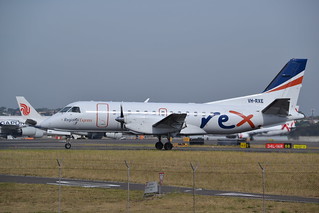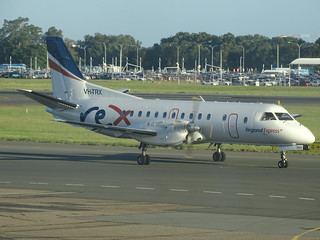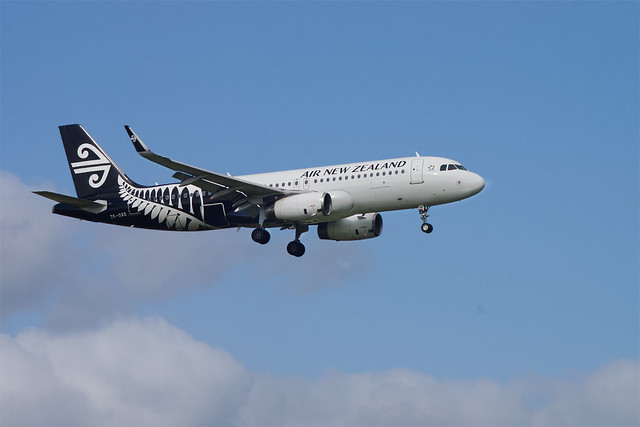REX SF34 at Orange on Feb 21st 2016, near collision with glider aircraft
Last Update: September 8, 2016 / 16:43:58 GMT/Zulu time
Incident Facts
Date of incident
Feb 21, 2016
Classification
Incident
Cause
Near collision
Airline
REX Regional Express
Flight number
ZL-177
Departure
Orange, Australia
Destination
Sydney, Australia
Aircraft Registration
VH-ZLA
Aircraft Type
SAAB 340
ICAO Type Designator
SF34
Australia's TSB reported on Feb 26th 2016, that the occurrence was rated a serious incident/near collision and is being investigated by the ATSB.
On Sep 8th 2016 the ATSB released their final report releasing following safety message:
Pilots are encouraged to ‘err on the side of caution’ when considering when to make broadcasts and whether specific frequencies should be monitored, particularly noting the fundamental importance of communication in the effective application of the principles of see-and-avoid. The ATSB report Limitations of the See-and-Avoid Principle outlines the major factors that limit the effectiveness of un-alerted see-and-avoid.
Insufficient communication between pilots operating in the same area is the most common cause of safety incidents near non-controlled aerodromes. A search for other traffic is eight times more effective when a radio is used in combination with a visual lookout than when no radio is used.
In areas outside controlled airspace, it is the pilot’s responsibility to maintain separation with other aircraft. For this, it is important that pilots use both alerted and un-alerted see-and-avoid principles. Pilots should never assume that an absence of traffic broadcasts means an absence of traffic.
The use of transponders greatly enhances safety in non-controlled airspace. The AIP states that pilots of aircraft fitted with a transponder must activate it at all times during flight. Transponders can be detected by aircraft equipped with TCAS, allowing them to detect other aircraft and initiate avoidance action. The use of ADS-B provides additional information to equipped aircraft.
Alerting technologies can be used as a ‘last line of defence’ to warn pilots of aircraft in their vicinity. The available technologies include:
- Portable TCAS, which can be plugged into a cigarette lighter or hardwired, however, these are not suitable for gliders due to their high power draw.
- Power FLARM is low power and short range so suited to gliders, but does not appear on an aircraft TCAS such as that fitted to ZLA.
- Cheaper ADS-B solutions which must have TSO approval. CASA currently does not mandate ADS-B for gliders but is examining the possibility of encouraging the voluntary use of ADS-B for all VFR aircraft if a low cost solution is available.
The ATSB reported the Saab 340 was climbing out of Orange with the first officer being the pilot flying and the captain being the pilot monitoring. Climbing through 6000 feet MSL the crew saw a cloud build up ahead and requested - and was approved - a deviation around that build up with ATC. When the captain was reading back that clearance, the aircraft was climbing through 7500 feet, the captain spotted a glider aircraft ahead just below the cloud base, immediately took control of the aircraft and lowered the nose of the aircraft to make sure the Saab passed below the glider aircraft. The Saab crew estimated the distance to the glider reduced to about 100 meters/330 feet.
The glider aircraft, participating in a coaching flight accompanied by a second glider aircraft, had departed Pipers Field and was heading towards Cowra descending through 8560 feet MSL about 11nm from Orange when the pilot noticed the departing Saab 340 in his 3 o'clock position climbing towards them, the pilot of the accompanying glider also alerted the pilot via their discrete frequency. The pilot assessed, that due to the climb rate the Saab would be passing below them with no risk of collision and continued his flight track.
The pilot of the accompanying glider reported that the Saab 340 passed between the first glider and him, slightly below the first glider but at the same altitude as him.
The ATSB annotated that the Saab 340 crew never saw the second glider aircraft.
The ATSB commented that the glider aircraft out of Pipers should be using 122.7MHz according to special procedures applied during the time. However, neither glider pilot used that frequency.
Part of the special procedure would have been that the Saab crew should have transmitted their intention not only to the assigned CTAF frequency, but also to 122.7MHz, however, due to workload that call was not made.
The ATSB commented that even if the Saab had transmitted their call on 122.7MHz besides CTAF too, the glider pilots would not have heard that transmission as they were on a different frequency.
However, had the glider pilots monitored the CTAF frequency, they would have become aware of the Saab 340. But there was no requirement to monitor CTAF or other area frequencies unless within 10nm of the uncontrolled aerodrome.
Australia's Civil Aviation Safety Agency (CASA) is working on a Safety Risk Profile - Aircraft Separation, not yet completed, which as of current list following findings:
- That the limitations of see-and-avoid are well documented and only through continued education and training will this be an effective risk control measure.
- On-board communications i.e. the use of radios will assist in pilot awareness and upgrade see-and-avoid to alert-and-avoid, this being a more effective risk control. Treatments have been identified in the areas of carriage and use of radios, English language standards, human factors training.
- Hardware was identified as an effective recovery measure. Since its introduction, airborne collision avoidance systems (such as TCAS) have been a proven risk control in the prevention of mid-air collision. Other hardware technologies are used and emerging which offer varying degrees of protection depending on design and intended application.
The ATSB reported that a working group including members of the gliding association are working on a proposal to fit ADS-B on glider aircraft stating:
Fitment of ADS-B technology in VFR aircraft enables awareness of other aircraft traffic, thereby improving aviation safety. The working group suggested that adopting appropriate standards and simplifying the installation process would encourage (voluntary) fitment of ADS-B technology in general aviation aircraft.
The proposal stated that if VFR aircraft were equipped with ADS-B OUT equipment, to the nominated standards, safety and efficiency would be significantly improved, because these aircraft would be visible to:
- aircraft with TCAS or other traffic advisory system;
- all aircraft with ADS-B IN; and
- air traffic control, when within line of sight coverage of ADS-B ground station.
Incident Facts
Date of incident
Feb 21, 2016
Classification
Incident
Cause
Near collision
Airline
REX Regional Express
Flight number
ZL-177
Departure
Orange, Australia
Destination
Sydney, Australia
Aircraft Registration
VH-ZLA
Aircraft Type
SAAB 340
ICAO Type Designator
SF34
This article is published under license from Avherald.com. © of text by Avherald.com.
Article source
You can read 2 more free articles without a subscription.
Subscribe now and continue reading without any limits!
Read unlimited articles and receive our daily update briefing. Gain better insights into what is happening in commercial aviation safety.
Send tip
Support AeroInside by sending a small tip amount.
Related articles
REX SF34 near Broken Hill on Oct 11th 2025, engine shut down in flight
A REX Regional Express Saab 340B, registration VH-KRX performing flight ZL-6854 from Sydney,NS to Broken Hill,NS (Australia), was enroute at FL120…
REX SF34 at Adelaide on Oct 8th 2025, rejected takeoff due to engine failure
A REX Regional Express Saab 340B, registration VH-ZPN performing flight ZL-4818 from Adelaide,SA to Broken Hill,NS (Australia), was accelerating for…
REX SF34 at Melbourne on Apr 5th 2022, flames and smoke during engine start prompt evacuation
A REX Regional Express Saab 340B, registration VH-ZRK performing flight ZL-3937 from Melbourne,VI to King Island,TA (Australia) with 23 passengers…
REX SF34 at Perth on Dec 21st 2022, engine shut down in flight
A REX Regional Express Saab 340B, registration VH-RXE performing flight ZL-2133 from Perth,WA to Albany,WA (Australia), was climbing through about…
REX SF34 at Merimbula on Jun 8th 2023, stick shaker activation on approach
A REX Regional Express Saab 340B, registration VH-TRX performing flight ZL-6139 from Moruya,NS to Merimbula,NS (Australia) with 22 passengers and 3…
Newest articles
Airjet Angola E145 at Kolwezi on Nov 17th 2025, touched down before runway, aircraft in flames
An Airjet Angola Embraer ERJ-145, registration D2-AJB performing flight MBC-100 from Lubumbashi to Kolwezi (DR Congo) with 26 passengers and 3 crew,…
ANZ A320 at Auckland on Nov 15th 2025, hydraulic problems
AN ANZ Air New Zealand Airbus A320-200, registration ZK-OXD performing flight NZ-637 from Auckland to Queenstown (New Zealand), was climbing out of…
Subscribe today
Are you researching aviation incidents? Get access to AeroInside Insights, unlimited read access and receive the daily newsletter.
Pick your plan and subscribePartner

ELITE Simulation Solutions is a leading global provider of Flight Simulation Training Devices, IFR training software as well as flight controls and related services. Find out more.
SafetyScan Pro provides streamlined access to thousands of aviation accident reports. Tailored for your safety management efforts. Book your demo today
AeroInside Blog
Popular aircraft
Airbus A320Boeing 737-800
Boeing 737-800 MAX
Popular airlines
American AirlinesUnited
Delta
Air Canada
Lufthansa
British Airways




